Random Noise 18
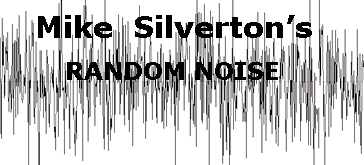
Random Noise 18
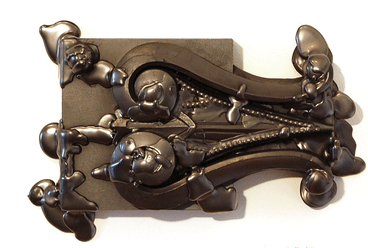
Oyaide’s Tunami GPX-R Power Cable
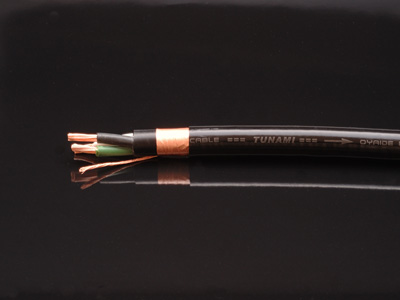 Some time ago I commented rather sourly on an audio-cable designer who boasted of his ability to tweak his goods to suit the customer’s preferences. “System too bright, I fix. System muddy, I fix.” I saw this as other than a sincere effort to produce the best, least colored cable possible within cost constraints. I owe the man an apology.
Some time ago I commented rather sourly on an audio-cable designer who boasted of his ability to tweak his goods to suit the customer’s preferences. “System too bright, I fix. System muddy, I fix.” I saw this as other than a sincere effort to produce the best, least colored cable possible within cost constraints. I owe the man an apology.
The Acoustic Revive cabling in this system includes Power Reference power cables, which I’ve recommended, as I have many of the AR items I’ve had the good fortune to use. Joe Cohen of Lotus Group USA asked if I’d like to cover Oyaide’s Tunami GPX-R Power Cable. (Oyaide is another Japanese company whose line Lotus distributes.) As for linkage, Oyaide provides the connecting hardware for Acoustic Revive’s power cables and Power Taps.
Yes, I certainly would like to check them out. Joe sent a pair of Tunami GPX-R’s I promptly installed in my Integris CDP (AurumAcoustics.com): from wall to Power Tap, from Power Tap to player. (Power Tap is AR’s name for its passive line conditioner. I’m using two: one for the CDP, the other for a pair of mono NuForce amps.) Wary of sitting out the maturation period new audio hardware seems to require, I asked for pre-cooked cables. Joe forgot and sent raw specimens.
Not a problem. The Oyaides performed beautifully from the start, which is to say, they did nothing obviously deleterious. Lest the comment strike you as persnickety or arch, be assured that many of the items I’ve received for review have sounded grainy or dull before rising to their various potentials.
The weeks I spent with the Oyaide pair proved a delight. This was a cable I’d recommend to anyone. Important here to mention that nothing else in the system had or has changed. AR’s RR-77 pulses away atop a book tower in a corner of the room. My NuForce monos draw their power from AR power cables via the Power Tap they share. AR’s large clear quartz pucks cap my two AR Power Taps’ inlets. Behind each of my WATT / Puppy 8 speakers stands an AR Room Tuning Panel. Quartets of Nordost’s Quasar Points support the amps. The CDP’s three steel points connect with a large Golden Sound DH pad. (Apart from its isolating properties, the pad protects a Chinese antique from the points’ aggressions.) Finally, I treat the CDs I play to a demagnetization and negative-ion shower by way of AR accessories. I’ve covered most of this in earlier columns and at another ezine.
After giving the Oyaide cables a thoroughly enjoyable run, I returned the AR cables. Now, with the understanding that A/B comparisons in a civilian’s listening room – even so discerning a civilian as your fabulous reporter – partake in no way of valid testing methods, the AR cables sounded more involving. I heard greater detail and a more clearly articulated image. But one comparison should not comprise the whole story. We subjectivists are the playthings of our moods. Of the stars. Of sunspots. Of phases of the moon. Of really nice single-malts. Of recent and distant romantic encounters.
And then, of course, we’ve the overarching issue of system dependency. In listening to cables I’ve been sent to review I’m obliged to remind myself that, as part of a system, they operate as an aspect of a totality. I owed it to these fine Oyaides to give them another go, perhaps with a third participant to enrich the mix.
Meanwhile, it occurred to me that the cable designer who told me he could change a system’s sound wasn’t just inflating hot-air balloons. If my impressions hold up to repetition, I will have demonstrated to myself – again – that audible distinctions among audiophile cables may simply be the expression of their ingredients’ quality and implementation. For example, the Oyaide and AR cables both employ PCOCC-A conductors (annealed, uni-crystal copper – it doesn’t get any better). And there the similarities end. For more about the pleasingly flexible GPX-R’s innards and elegant terminations, go to LotusGroupUSA.com and click on the Oyaide link. Enough here to mention that the Oyaide’s conductors are multi-strand twists and that AR’s trio of stiff, beefy wires are just that: three stiff, beefy wires per power cord. In my admittedly narrow experience, the AR’s design is unconventional. If other manufacturers incorporate woven silk sleeves under coils of Teflon-coated copper as sheathing for the core conductors, please inform. Till I hear from you, I’ll continue to see these features as unique and, from the evidence, effective.
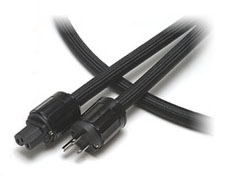 This is certainly not to slight Oyaide. I’d never characterize this cable as other than fine. However, a second comparison session confirmed my preference for Acoustic Revive’s Power Reference. The test tracks, which also included a comparison with Cardas Golden Reference power cords left me with the feeling – and let’s bear in mind that we’re discussing system-dependent impressions – that the Oyaide offers a slightly creamier presentation and is a tad less exquisitely focused. And let a tad’s girth be that of an RCH, an indelicate acronym denoting the least degree of difference, as in, “Move it to the left an RCH – no, no, too much!” The term, familiar primarily to techies and members of the building trades, refers to the diameter of a hair at a certain part of a lady rat’s rear. At least that’s what I understood: “R” for rat. In the interest of completeness, the “R” also stands (I only now learned) for “Red” or “Royal.” I’ve consulted my Emily Post. It would be in poor taste to go into further detail.
This is certainly not to slight Oyaide. I’d never characterize this cable as other than fine. However, a second comparison session confirmed my preference for Acoustic Revive’s Power Reference. The test tracks, which also included a comparison with Cardas Golden Reference power cords left me with the feeling – and let’s bear in mind that we’re discussing system-dependent impressions – that the Oyaide offers a slightly creamier presentation and is a tad less exquisitely focused. And let a tad’s girth be that of an RCH, an indelicate acronym denoting the least degree of difference, as in, “Move it to the left an RCH – no, no, too much!” The term, familiar primarily to techies and members of the building trades, refers to the diameter of a hair at a certain part of a lady rat’s rear. At least that’s what I understood: “R” for rat. In the interest of completeness, the “R” also stands (I only now learned) for “Red” or “Royal.” I’ve consulted my Emily Post. It would be in poor taste to go into further detail.
I concentrated on two test tracks from a Bach cantata, Herr Jesu Christ, wahr’ Mensch und Gott, BWV 127, John Eliot Gardiner conducting the English Baroque Soloists, vocal soloists, and the Monteverdi Choir, Soli Deo Gloria CD SDG 118, volume 21 of the series. The soprano aria, Die Seele ruht in Jesu Händen, with a small instrumental accompaniment, is followed by a more assertive bass recitative and aria, Wenn einstens die Posaunen schallen, to a accompaniment in which brass plays a part. Between these two you get a pretty solid read on differences in hardware.
Both cables are dead-silent. Oyaide has gone to obvious pains in that department. (I won’t go into detail over the Cardas cable. Enough to say it’s a little different in character from AR and Oyaide. Had it offered livelier competition, I’d be more explicit.) The Oyaide is less expensive: $495 for 1.8 meters as compared with $725 for a 2-meter Acoustic Revive. I suspect, however, that perfectionists willing to consider cabling in this middling-to-extravagant range won’t be put off by the difference.
The tsunami that devastated Banda Oceh, Indonesia, occurred in 2003. I’m told that Oyaide came up with its Tunami handle in 2005. Tsunami is a Japanese word that translates as big wave. According to a Japanese acquaintance, tunami and tsunami share the same meaning. Perhaps someone forgot to attend the sensitivity seminar.
What’s in a name? Depends. Studebaker, a long-defunct American car company, introduced the Dictator in 1927, at a time when Italy’s Benito Mussolini was much admired in the USA as a paragon of effective management. Hitler’s less savory reputation inspired Studebaker to drop the name in 1937, substituting Commander, with its less worrisome connotations, particularly as an export to Europe. A tsunami sweeps all before it. Invincible. Irresistible. You never know – somewhere in merchandising’s roiling Sargasso a cable designer is thinking of calling his latest line Genocide by way of suggesting the competition’s annihilation. Anyway, it’s been a pleasure and a re-education. Cables make a difference.
Loose ends
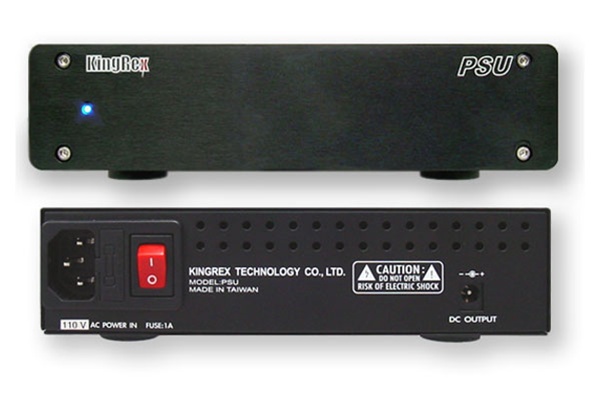 If you’re thinking of acquiring an Acoustic Revive RR-77 Ultra Low Frequency Pulse Generator (the Illuminati and other secret-handshake types call it the Schumann Resonance Generator), or if you have one, you may remember my suggesting that you replace the wall wart with a KingRex Power Supply Unit (PSU). The guys at Audio-Magus.com provide well-made umbilicals, your choice of length, to replace the included jumper. I’m using their eight-footer. As to loose ends, I wasn’t informed when I ordered the PSU – grrr! – that Audio Magus can replace the unit’s flimsy output fitting with a sturdy Switchcraft upgrade. The recommended mod costs an additional $35.
If you’re thinking of acquiring an Acoustic Revive RR-77 Ultra Low Frequency Pulse Generator (the Illuminati and other secret-handshake types call it the Schumann Resonance Generator), or if you have one, you may remember my suggesting that you replace the wall wart with a KingRex Power Supply Unit (PSU). The guys at Audio-Magus.com provide well-made umbilicals, your choice of length, to replace the included jumper. I’m using their eight-footer. As to loose ends, I wasn’t informed when I ordered the PSU – grrr! – that Audio Magus can replace the unit’s flimsy output fitting with a sturdy Switchcraft upgrade. The recommended mod costs an additional $35.
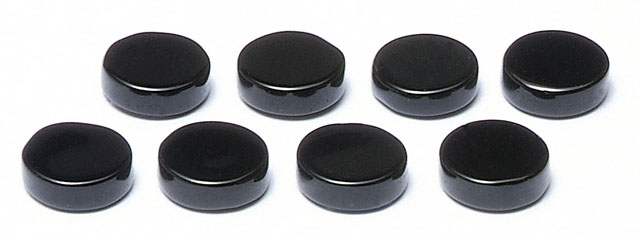
My couchbound adventures with Acoustic Revive’s large quartz pucks have kept me in a state of amused bemusement, bemused amusement and grist for the mill. With us audiophiles, stasis is death, damn the torpedoes, and water the geraniums. When I last commented on placement and swaps, smoky for clear, clear for smoky, cha cha cha, I came down in favor of clear. Because I heard them muddying the sound to the tiniest degree (really, not much more than an RCH), I retired the smokies to a drawer. Perhaps because I now had the amps’ and CDP’s Power Taps plugged into Oyaide’s supremely resolving R-1 outlets, I got a quite lovely result with five smoky pucks stationed hither and yon. What earlier sounded a bit muddy since translated to a welcome warmth. I did mention in the earlier report that these mystifying objects require experimentation. Think of them as checkers and your system as the checker board.
I also mentioned that, owing to a scarcity of quartz of this size – at least at this price – the pucks may soon be in short supply. If you’re interested, this could be The Moment. Ask your neighborhood AR dealer if he can lend you a few. If there’s no dealer on your block – audio I mean – go to info@LotusGroupUSA.com for help. (Since keying in these thoughts, I returned to clear, most recently reducing the count to two, as mentioned above: one each atop the Power Taps’ IEC males. More about AR-related maneuvers in the next column.)
Music
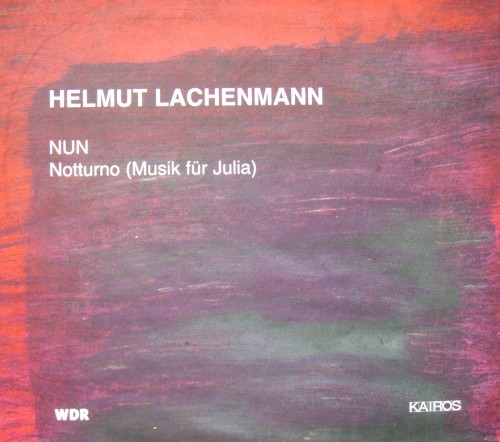
Helmut Lachenmann’s music speaks to the nihilistic aesthete within this brittle ribcage. You never heard of the man whose uniquely eye-crossing work stands as a brilliant furtherance of the European avant-garde’s Cloud-9 adventures, with particular respect to the movement’s abandonment of Romantic rhetoric and gestures, along with that of periods earlier still? In the words of Claude Rains’ Captain Renault, I’m shocked – shocked!
With Lachenmann, conventions of narrative and mood give way, for this listener, to energizing abstractions. His work is about itself and nothing else, and perhaps even nothing. Lachenmann nicely bridges Western art music’s loftier aspects with thumb-in-your-eye noise. In terms of a culture’s evolution in the hands of a powerfully gifted composer, Lachenmann’s on to something few of his contemporaries and forbears have attempted or perhaps find desirable. Think of engagement and detachment in equal measure within a single work. The man is saying in effect, “I do what I do, and you, dear listener, are on your own.” I like that attitude, particularly in a period when conservatory-trained hacks crank out their sounding sausages in hope of attracting an audience well along their way to nursing homes and hospices.
Think as well of a curiously fascinating aural assemblage that persists in dismantling as you try to grasp its free-floating shards. This gives a crude idea of how a favorite Lachenmann piece comports itself. I recommend for your pleasure or engaged befuddlement NUN, for flute, trombone, vocalists, and orchestra [Kairos CD 0012142KAI, released in 2001]. The recording, by West German Radio, is sublimely detailed, a necessity for works of this kind. I cannot predict your response but am reasonably certain you won’t be bored. An earlier work, Notturno (Musik für Julia), for small orchestra and cello, and also a daisy, rounds out the program.
Be well and have a care for your ears.

![]()
Don’t forget to bookmark us! (CTRL-SHFT-D)
Stereo Times Masthead
Publisher/Founder
Clement Perry
Editor
Dave Thomas
Senior Editors
Frank Alles, Mike Girardi, Key Kim, Russell Lichter, Terry London, Moreno Mitchell, Paul Szabady, Bill Wells, Mike Wright, Stephen Yan, and Rob Dockery
Current Contributors
David Abramson, Tim Barrall, Dave Allison, Ron Cook, Lewis Dardick, Dan Secula, Don Shaulis, Greg Simmons, Eric Teh, Greg Voth, Richard Willie, Ed Van Winkle, and Rob Dockery
Music Reviewers:
Carlos Sanchez, John Jonczyk, John Sprung and Russell Lichter
Site Management Clement Perry
Ad Designer: Martin Perry





Be the first to comment on: Random Noise 18